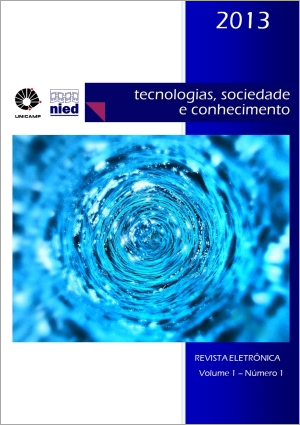Resumo
Neste trabalho é criada e proposta uma metodologia geral com um modelo de processos para a realização de sessões de aprendizagem considerando um entorno colaborativo com interação síncrona mediada por ferramentas digitais. Com a inclusão de tecnologias na educação, se observa que não é suficiente tornar as ferramentas disponíveis a educadores e aprendizes. Identificou-se uma carência de metodologias que guiam a criação de novas formas de desenho instrucional, baseado na interação por meio de ferramentas digitais. Além disso, evidenciou-se que a maioria das plataformas de aprendizagem explora somente uma interação assíncrona.
Referências
ALAVI, M. Computer–mediated collaborative learning: An Empirical evaluation. MIS Quarterly, 1994, v.18, p.159-174.
CAMPOS, G.; ROQUE, G.; AMARAL, S. Dialética da Educação à distância, Rio de Janeiro: PUC Rio, 2007.
CHAO, K. -J.; HUNG, I.-C.; CHEN, N.-S. On the design of online synchronous assessments in a synchronous cyber classroom. Journal of Computer Assisted Learning, v.28, p.379-395, 2011.
CHICKERING, A.W.; EHRMANN, S.C. Implementing the Seven Principles: Technology as Lever. American Association for Higher Education Bulletin, 1996, v.49, n.2, p.3-6.
DEWIYANTI, S.; BRAND-GRUWEL, S.; JOCHEMS, W.; BROERS, N. Students experiences with collaborative learning in asynchronous computer-suported collaborative learning environments.Computer in Human Behavior, 2007, v.23, p. 496-514.
HANNAFIN, M. Emerging Technologies, ISD and learning environments: critical perspectives. Educational Technology Research & Development,1992, v.40, p.49-63.
HURME, T.; JARVELA, S. Students’ activity in computer-supported collaborative problem solving in mathematics. International Journal of Computers for Mathematical Learning, v.10, p.49-73,2005.
JARA, C. A.;CANDELAS, F. A.; TORRES, F.; DORMIDO S.; ESQUEMBRE F.; REINOSO, O. Real-time Collaboration of Virtual Laboratories through the Internet. Computers & Education, 2009, v.52, p.126-140.
JOHNSON, D. W.; JOHNSON, R. T. Learning together and alone. Cooperative, competitive and constructivist learning environments. Boston, MA: Publisher Alyne and Bacon, 1999.
KOSCHMANN, T. Toward a theory of computer support for collaborative learning. Journal of the Learning Sciences, v.3, p. 219-225,1994.
LAZAKIDOU, G.; RETAILS, S. Using computer supported collaborative learning strategies for helping students acquire self-regulated problem-solving skills in mathematics. Computers & Education,2010, v.54, n.1,p.3-13.
MARJANOVIC, O. Learning and teaching in a synchronous collaborative environment. Journal of Computer Assisted Learning, v.15, p.129-138, 1999.
TSUEI, M. Using synchronous peer tutoring system to promote elementary students’ learning in mathematics. Computers &Education, 2011, v.58, p.1171-1182.
VIGOTSKY, L. S. A formação social da mente. São Paulo: Martins, 1991

Este trabalho está licenciado sob uma licença Creative Commons Attribution 4.0 International License.
Copyright (c) 2013 Tecnologias, Sociedade e Conhecimento

